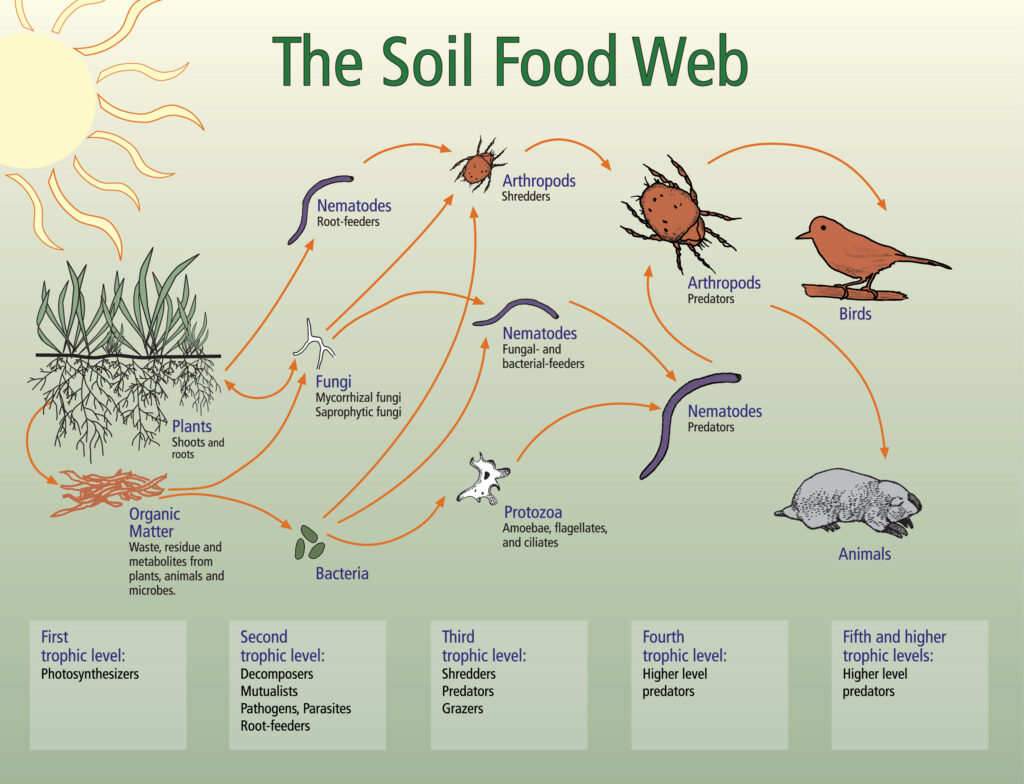Regenerative Agriculture Primer
Why It Matters
The precious blue-green planet we live and depend on is in dire ecological crisis: our planet’s ability to continue supporting life is increasingly at risk unless humanity shifts to a more sustainable path: Global heating, droughts & wildfires, dying coral reefs, biodiversity collapse (6th mass extinction), dead lakes, drained aquifers, polluted waterways, disappearing rivers lakes & reservoirs, endocrine disruptors and toxic chemicals in our bodies, supply chain disruptions from depleted resources, and most recently a global pandemic, which is itself aggravated by human-and-wildlife crowding, diminished wilderness habitats and violating ecological/species boundaries…
Agriculture (i.e. the growing of crops such as cannabis/hemp) has a significant environmental footprint:
Agriculture is associated with ~1/3 of global land use, and is a key driver of land use change (the degradation/destruction of natural ecosystems). Crop production is also associated with ∼15% of global greenhouse gas emissions.
Intensive industrial agriculture requires fossil fuels, fertilizers, pesticides and massive irrigation which brings ecological costs that now include global heating, soil degradation, habitat and biodiversity loss, toxic pollution, bee colony collapse, nutrient cycle disruption, fresh water depletion, and diminishing agricultural returns from additional fertilizer and pesticide use.
Recent reports indicate that 38 percent (nearly 1.4 billion acres) of our planet’s agricultural land has been degraded by unsustainable agricultural practices…

However all is not yet lost:
An increasing number of eco-restoration success stories are demonstrating, inspiring and encouraging us that nature can rapidly regenerate and heal itself:
Solutions to our ecological problems are now known, fully at hand/available, and within each of our power to deploy, much of the damage humanity has caused can be reversed, quickly, once the sustainable shift is made, all it takes is each of us making the conscious choice to travel the sustainable/regenerative path:
Humanity could collectively sequester more than 100% of current annual CO2 emissions with a full-scale switch to widely available and inexpensive regenerative organic agriculture management practices, which bring additional synergistic benefits like restoring highly degraded soil which symbiotically enhances the quality of water, vegetation and land-productivity.
Regenerative Ag delivers (vs. industrial ag):
- 40% higher yield more in times of drought
- 3-6x greater profits for farmers
- Improves soil health and builds soil organic matter (can add/create 4-6″ of topsoil per year!)
- 45% less energy use
- 40% fewer carbon emissions
- Zero leaching of atrazine or other toxic chemicals into waterways
International and Intergovernmental Panels now list regenerative agriculture as a viable “sustainable land management practice” focused on ecological functions that “can be effective in building resilience of agro-ecosystems.” At a local level, there are several cases of municipal governments in the US exploring the potential for regenerative agriculture to help achieve local sustainability goals.
Regenerative agriculture is an alternative means of producing crops that can bring lower—and even net positive—environmental and social impacts. (Compared to today’s large-scale industrialized big-ag which even though it’s often called “conventional”, isn’t actually all that conventional since industrialized “conventional” ag is a relatively recent invention, having only been practiced since chemical fertilizers and synthetic pesticides/poisons were invented in the 1940s, for the previous 15,000+ years of human civilization all agriculture was 100% organic…)
No-one can do everything, everyone can do something ~ :
The day-to-day choices you make as you manage/operate your grow can either contribute to the (planet’s ecological) problem or contribute to the solution… The Future Is Regenerative!
We’ve prepared this primer to help awaken and inspire more people to be part of the solution and help make positive shift happen: if we all run our grows 100% regenerative then together we can save and even heal & regenerate our precious planet!
Regenerative Agriculture Defined
There is no official legal or regulatory definition of the term “regenerative agriculture” nor has a widely accepted definition emerged in common usage, Regenerative Agriculture has been defined in a variety of ways.
All with common themes involving “a system of farming principles and practices that increases biodiversity, enriches soils, improves watersheds, and enhances ecosystem services”
– and/or –
“a long-term, holistic design that attempts to grow as much food using as few resources as possible in a way that revitalizes the soil rather than depleting it, while offering a solution to carbon sequestration”
Regenerative ag is often defined in terms of processes (including principles and/or practices), outcomes/goals, or both.
Ecological Principles
Regenerative agriculture is based on the principle of working with nature and supporting a natural ecosystem’s tendency (if not interfered with by humans) to naturally regenerate and perpetuate itself:
“Nature is our teacher. Earth’s ecosystems have followed and co-evolved certain principles to sustain life from its very beginning. With a four billion-year track record of success, Nature is inherently sustainable, human society and industry need to follow these same principles. A sustainable human community is designed in such a manner that its ways of life, businesses, economy, physical structures and technologies respect, honor and cooperate with Nature’s inherent ability to sustain life.” (Fritjof Capra)
– and –
“In natural ecosystems a multitude of different individuals and diverse species stand in various relations with one another — competition and cooperation, partnership and predation, productivity and destruction. All these relations, however, follow one higher law: over the long run only behavior that allows for productivity of the whole ecosystem and that does not interrupt its self-production is amplified. The individual can realize itself only if the whole can realize itself. ” (Andreas Weber, The Biology of Wonder)

Ecological principles (aka mother nature’s operating rules) include:
One species’ waste is another species’ food;
Matter cycles continually through the web of life (a living system is a dissipative system);
Solar energy drives ecological cycles;
Diversity assures resilience; and
Life did not take over the planet by combat & competition but by networking & symbiosis…

Processes Practices & Techniques
The most commonly-employed regenerative agriculture processes/techniques include:
- Emphasis on no or low external inputs and the utility of on-farm inputs
- Integration of livestock
- Not using synthetic fertilizers or pesticides
- Reducing or eliminating tillage
- Use of cover crops including dynamic accumulators
Full list of regenerative processes/principles/techniques:
- Reduce tillage (or no-, minimal-, conservation-)
- Protect/cover the soil
- Use cover crops including dynamic accumulators
- Use crop rotations
- Use crop plant diversity (including intercropping)
- Incorporate perennials and trees (agroforestry & silvopasture)
- Restore natural habitats & native species
- Integrate livestock
- Use ecological or natural principles or systems
- Use no or low external inputs; maximize on-farm inputs (incl. dynamic accumulators)
- Use organic methods
- Use natural pest control
- Use no synthetic pesticides
- Use organic fertilizers
- Use compost, mulch, green manure, or crop residues
- Use no synthetic fertilizers
- Focus on localism and/or regionality
- Focus on small scale systems
- Rely on farm labor, including for local knowledge

Outcomes
Most common outcomes/goals = aspirations to:
improve soil health
sequester carbon
increase biodiversity
improve water resources
enhance ecosystem services (water flow regulation, pest regulation, waste detoxification & bioremediation, air quality regulation, storm protection, pollinator and wildlife habitat, etc.)
improve the social and/or economic wellbeing of communities
Full list of regenerative agriculture outcomes & goals:
Improve ecosystem health (including ecosystem services)
Increase biodiversity
Improve water health (hydrology, storage, reduce pollution)
Improve soil health (structure, soil organic matter, fertility)
Increase carbon sequestration
Reduce greenhouse gas emissions
Improve animal welfare
Maintain or increase yields
Maintain or improve farm productivity
Increase crop health and/or resilience
Improve food access and/or food security
Improve food nutritional quality and/or human health
Improve food safety
Improve the social and/or economic wellbeing of communities
Increase farm profitability
To create a circular/closed-loop/cradle-to-cradle system and/or reduce waste
Benefits of regeneratively bred cannabis/hemp seeds
Many of the seed selections in our Motor City Seeds lineup are from breeders who practice, live & breathe regenerative agriculture on their farms. Regeneratively bred and grown seeds tend to show higher vigor vitality and overall performance:
Regeneratively-bred seed arrives coated with beneficial biology. When the seed is planted in your living soil the beneficial microbes wake up, kickstart & up-shift the germination process.
Regeneratively-bred genetics are accustomed to using the soil mycorrhizal network to access nutrients on demand.
- Regeneratively-grown seeds and crops test at significantly higher levels of nutrient density and composition: vitamins, minerals, micronutrients and phytochemicals.
- Grower reports: “Over the years of running many seeds it became apparent that when I used seed grown with synthetic nutrients it would take two to three cycles to get the plants performing at peak levels. when using seeds raised in living soils that are teeming with microbes the plants take off and respond immediately.” and:
- “Trying to be a part of the ecosystem naturally, expresses itself through better cannabis plants. We’ve seen the results even in testing; the more natural your environment means the higher the potency, higher terpenes, and a better plant.”
Regenerative Ag & Permaculture Philosophy
The philosophy of sustainable agriculture embraces many different (and alternative) methods, which may be considered ‘organic’, ‘low-input’, ‘free-range’, ‘biodynamic’, ‘integrated’ and ‘holistic’. At their core, these approaches all embody farming practices that simulate processes of natural ecology.
The introduction of ‘regenerative’ practices requires a fundamental redesign of the system, so that the resource base is restored and revivified by means of natural ecological services. Regenerative agriculture has at its core the intention to improve the health of soil or to restore highly degraded soil, which symbiotically enhances the quality of water, vegetation and land-productivity. It typically employs techniques that are used more generally in organic agriculture, with the aim to preserve/build soil organic matter, including minimum tillage, growing cover crops and green manures, composting, mulching and crop rotation. Its best practices mandate an avoidance of artificial inputs – pesticides, fertilisers, herbicides – that damage the living organisms in the soil.
Keyline design: Keyline planning follows the natural topography of the land, and uses this to determine the best location for farm dams, irrigation areas, roads, fences, farm buildings and tree lines.
The method causes minimum disturbance to the overall soil profile, and in contrast with conventional ploughing, avoids causing harm to plants that are already growing in the area and does not injure the soil food web. The technique serves to spread water evenly across the landscape, by ploughing in a very specific pattern, according to the topography of that landscape.
Keyline design combines cultivation, irrigation, and stock management techniques to greatly speed up the natural process of soil formation, and results of 400 to 600 tons of topsoil per acre each year are possible. Keylining can annually deepen topsoil four to six inches, and darken it a meter deep in less than a decade…
Permaculture: According to Holmgren, “A more current definition of permaculture is ‘Consciously designed landscapes which mimic the patterns and relationships found in nature, while yielding an abundance of food, fibre and energy for provision of local needs.’ People and their buildings, and the ways they organise themselves, are central to permaculture. Thus the permaculture vision of permanent (sustainable) agriculture has evolved to one of permanent (sustainable) culture.”
Broadly, permaculture may be classified as a branch of ecological design and ecological engineering which aims to develop sustainable human settlements and self-maintained agricultural systems modelled from natural ecosystems.
Permaculture is about making an effective design, emphasising patterns of landscape, function, and species assembly. It asks the questions: Where does this element go? How can it be placed with other elements for the maximum benefit of the system overall? The fundamental principle of permaculture is, therefore, to maximise useful connections between elements to achieve their best synergy in the final, and optimal design.
A regenerative farm based on permaculture principles will develop an evolving ecological structure and biological production that increases in its complexity with time; a characteristic of such a system is that once established, the overall biological yields continue to increase, while external inputs decrease. For the system to be regenerative, there must be an increase in both biodiversity and quantity of biomass…”
Citations/info-sources:
Limits to Growth: 50 years later, Rex Weyler, Greenpeace, May 1 2022, accessed from https://www.greenpeace.org/international/story/53539/limits-to-growth-book-eccology-50-years/ on 2022/07/24, Amsterdam The Netherlands
From The Limits to Growth to Regeneration 2030, Jeffrey Sachs, June 7 2022, accessed from https://www.clubofrome.org/blog-post/sachs-from-limits-to-growth-to-regeneration/ on 2022/07/24, Zurich Switzerland
Pushing Earth beyond its natural limits – in pictures, Rockström & Klum, The Guardian, April 14 2015, accessed from https://www.theguardian.com/sustainable-business/gallery/2015/apr/14/pushing-beyond-earth-limits-natural-world on 2022/07/24, London England
A safe operating space for humanity [Planetary Boundaries original paper], Rockström et al, Nature, September 24 2009, Vol 461, London England
Planetary boundaries: Guiding human development on a changing planet [the 5-year update], Steffen et al, Science, Feb 13 2015, Vol 347 Issue 6223, doi:10.1126/science.1259855, Washington DC
What Is Regenerative Agriculture? A Review of Scholar and Practitioner Definitions Based on Processes and Outcomes, Newton Civita Frankel-Goldwater Bartel & Johns, Frontiers in Sustainable Food Systems, October 2020 Volume 4 Article 577723, doi: 10.3389/fsufs.2020.577723, Lausanne Switzerland
The Imperative For Regenerative Agriculture, Christopher Rhodes, Science and Progress, 2017, Volume 100(1), 80 – 129, Paper 1700224, doi:10.3184/003685017X14876775256165, Los Angeles California
Regenerative Agriculture and the Soil Carbon Solution, Moyer Smith Rui & Hayden, Rodale Institute, September 2020, https://rodaleinstitute.org/education/resources/regenerative-agriculture-and-the-soil-carbon-solution/, Kutztown Pennsylvania
What Is Regenerative Agriculture, California State University (Chico) Regenerative Agriculture Initiative and The Carbon Underground, February 24 2017, Chico California
Soil Health And Nutrient Density: Preliminary Comparison Of Regenerative And Conventional Farming, Montgomery Biklé Archuleta Brown & Jordan, PeerJ Life & Environment, 2022, 10:e12848 DOI 10.7717/peerj.12848, London UK
Cite this page as: Regenerative Agriculture Primer, Motor City Seeds Team, August 21 2022, accessed from https://motorcityseeds.org/regenerative-agriculture-primer, Detroit Michigan
Learn more about our mission




